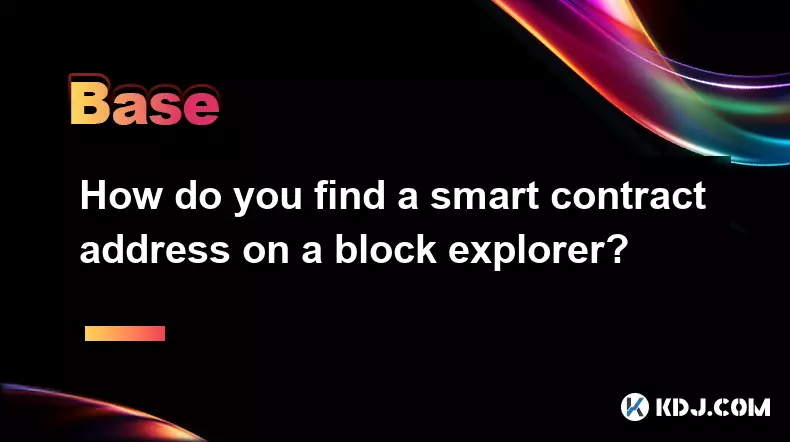-
 bitcoin
bitcoin $101752.865364 USD
-1.09% -
 ethereum
ethereum $3382.985899 USD
-1.38% -
 tether
tether $0.999658 USD
0.04% -
 xrp
xrp $2.272505 USD
-1.51% -
 bnb
bnb $989.089004 USD
0.14% -
 solana
solana $156.962612 USD
-3.08% -
 usd-coin
usd-coin $0.999776 USD
0.01% -
 tron
tron $0.290786 USD
-0.69% -
 dogecoin
dogecoin $0.174594 USD
-2.86% -
 cardano
cardano $0.560085 USD
-3.55% -
 hyperliquid
hyperliquid $40.023704 USD
-5.75% -
 chainlink
chainlink $15.324649 USD
-2.78% -
 bitcoin-cash
bitcoin-cash $493.576540 USD
-3.52% -
 zcash
zcash $571.320038 USD
-12.05% -
 stellar
stellar $0.280066 USD
-4.26%
How do you find a smart contract address on a block explorer?
A smart contract address is a unique 42-character identifier on a blockchain where the contract's code lives, generated when deployed and viewable on block explorers like Etherscan or BscScan.
Nov 08, 2025 at 01:40 pm

Understanding Smart Contract Addresses on Block Explorers
A smart contract address is a unique identifier on a blockchain where the contract's code resides. Unlike regular wallet addresses, these are generated through specific cryptographic processes when a contract is deployed. To interact with or verify a smart contract—such as checking its functions, balance, or transaction history—you need to locate it on a block explorer. This process involves navigating tools like Etherscan for Ethereum, BscScan for Binance Smart Chain, or other chain-specific explorers.
Steps to Locate a Smart Contract Address
- 1. Identify the correct blockchain network where the contract operates. For example, use Etherscan for Ethereum-based contracts and BscScan for those on Binance Smart Chain.
- 2. Open your preferred block explorer in a web browser. Ensure you're on the official website to avoid phishing risks.
- 3. Paste the smart contract address into the search bar at the top of the page. This address typically starts with '0x' and is 42 characters long.
- 4. Press Enter or click the search icon. If the address is valid and corresponds to a contract, the explorer will redirect to its dedicated page.
- 5. Review the information displayed, including contract name, owner, token type (if applicable), and verified source code.
Verifying Contract Details and Code
- 1. Once on the contract’s page, check if the source code has been verified. Verified contracts display a “Contract” tab with readable code.
- 2. Look for the contract creator’s address under the 'Transactions' section, particularly in the initial deployment transaction labeled as “Contract Creation.”
- 3. Examine the “Read Contract” and “Write Contract” sections to interact with its public functions directly through the explorer interface.
- 4. Review the list of recent transactions involving the contract to understand its activity level and usage patterns.
- 5. Check for security audit badges or labels such as “Proxy,” “Beacon,” or “Upgradable” that indicate complex architecture requiring deeper scrutiny.
Analyzing Token Contracts and Ownership
- 1. For token contracts, confirm whether it follows standards like ERC-20, BEP-20, or ERC-721 by reviewing the functions listed under the “Contract” tab.
- 2. Use the “Token Holders” section to view distribution across wallets. Concentrated holdings may signal centralization risks.
- 3. Investigate minting and burning functions within the code to determine if new tokens can be created post-launch.
- 4. Search for renounced ownership status—if the owner has relinquished control, this reduces manipulation risk.
- 5. Cross-reference third-party platforms like DeFi Pulse or DappRadar to see if the token powers an active decentralized application.
Always double-check the contract address from multiple trusted sources before interacting. Fake or cloned contracts often mimic legitimate ones using similar names or slight address variations.
Use explorers with built-in fraud detection features. Some platforms flag suspicious contracts based on heuristics like hidden functions or misleading metadata.
Interact with unverified contracts only through read-only functions unless you fully trust the deployment source and have conducted independent analysis.
Frequently Asked Questions
What does it mean when a contract is not verified?When a contract isn't verified, its source code isn't publicly available on the explorer. This makes it difficult to assess its functionality and increases risk, as malicious logic could be hidden.
Can I find a contract without knowing its address?Yes, but it's challenging. You can search by transaction hash related to its deployment or browse dApp directories linked to verified projects. However, having the exact address is the most reliable method.
How do I know if a contract address is fake?Compare the address against official project websites, social media channels, or community announcements. Scammers often use lookalike addresses with minor character changes, so inspect every digit carefully.
Is it safe to interact with a contract via a block explorer?Reading data is generally safe. Writing to the contract requires signing transactions with your wallet. Only proceed if you understand the function being called and trust the contract’s legitimacy.
Disclaimer:info@kdj.com
The information provided is not trading advice. kdj.com does not assume any responsibility for any investments made based on the information provided in this article. Cryptocurrencies are highly volatile and it is highly recommended that you invest with caution after thorough research!
If you believe that the content used on this website infringes your copyright, please contact us immediately (info@kdj.com) and we will delete it promptly.
- Ripple (XRP) in 2026: Hold or Fold? A Look at XRP's Future and Emerging DeFi Alternatives
- 2025-11-08 18:35:01
- Zcash ZEC Coin Price Explosion: From Privacy Niche to Center Stage
- 2025-11-08 18:55:01
- Berachain Price Prediction: Navigating the Honeycomb Hype in Crypto
- 2025-11-08 18:55:01
- Arthur Hayes, Gold, and Bitcoin: A Modern Monetary Trinity?
- 2025-11-08 19:15:01
- Shiba Inu's Next Move: Navigating a Shifting Market
- 2025-11-08 19:20:01
- Pakistan's Crypto Crossroads: Balancing Opportunity with Asset-Backed Realities
- 2025-11-08 19:20:01
Related knowledge

What is a "crypto airdrop farmer" and what strategies do they use?
Nov 09,2025 at 03:39pm
What Is a Crypto Airdrop Farmer?1. A crypto airdrop farmer is an individual who actively participates in blockchain projects to qualify for free token...

How does a crypto insurance protocol work?
Nov 08,2025 at 12:39am
Understanding Crypto Insurance Protocols1. A crypto insurance protocol operates by offering financial protection against losses incurred from digital ...

What is token composability and why is it called "DeFi Legos"?
Nov 09,2025 at 06:39am
Bitcoin's Role in Decentralized Finance1. Bitcoin remains the cornerstone of decentralized finance, serving as a benchmark for value and trustlessness...

What is an "exploit" versus a "hack" in the context of smart contracts?
Nov 09,2025 at 12:40am
Understanding Exploits in Smart Contracts1. An exploit refers to the utilization of a known vulnerability within a smart contract’s code to gain unint...

What is a decentralized storage network and how does it compare to cloud services?
Nov 07,2025 at 11:59pm
Understanding Decentralized Storage Networks1. A decentralized storage network distributes data across a peer-to-peer infrastructure rather than relyi...

What is a "generalized frontrunner" bot and how does it operate?
Nov 09,2025 at 02:00pm
Understanding the Generalized Frontrunner BotA generalized frontrunner bot is an automated trading program deployed on blockchain networks, particular...

What is a "crypto airdrop farmer" and what strategies do they use?
Nov 09,2025 at 03:39pm
What Is a Crypto Airdrop Farmer?1. A crypto airdrop farmer is an individual who actively participates in blockchain projects to qualify for free token...

How does a crypto insurance protocol work?
Nov 08,2025 at 12:39am
Understanding Crypto Insurance Protocols1. A crypto insurance protocol operates by offering financial protection against losses incurred from digital ...

What is token composability and why is it called "DeFi Legos"?
Nov 09,2025 at 06:39am
Bitcoin's Role in Decentralized Finance1. Bitcoin remains the cornerstone of decentralized finance, serving as a benchmark for value and trustlessness...

What is an "exploit" versus a "hack" in the context of smart contracts?
Nov 09,2025 at 12:40am
Understanding Exploits in Smart Contracts1. An exploit refers to the utilization of a known vulnerability within a smart contract’s code to gain unint...

What is a decentralized storage network and how does it compare to cloud services?
Nov 07,2025 at 11:59pm
Understanding Decentralized Storage Networks1. A decentralized storage network distributes data across a peer-to-peer infrastructure rather than relyi...

What is a "generalized frontrunner" bot and how does it operate?
Nov 09,2025 at 02:00pm
Understanding the Generalized Frontrunner BotA generalized frontrunner bot is an automated trading program deployed on blockchain networks, particular...
See all articles





















![The Graph Price Prediction [GRT Crypto Price News Today] The Graph Price Prediction [GRT Crypto Price News Today]](/uploads/2025/11/07/cryptocurrencies-news/videos/690d4df44fe69_image_500_375.webp)




















































